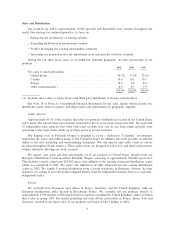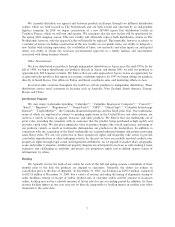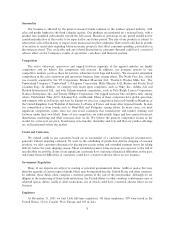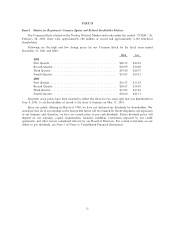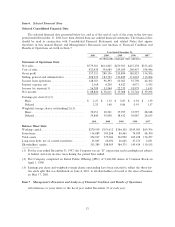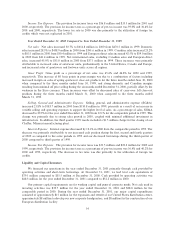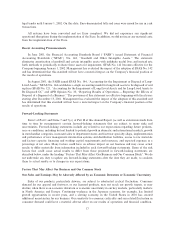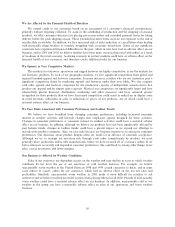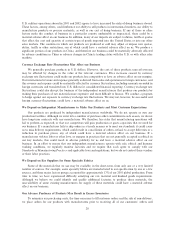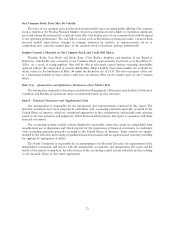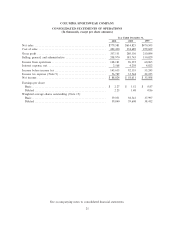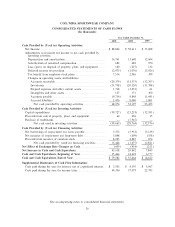Columbia Sportswear 2001 Annual Report Download - page 22
Download and view the complete annual report
Please find page 22 of the 2001 Columbia Sportswear annual report below. You can navigate through the pages in the report by either clicking on the pages listed below, or by using the keyword search tool below to find specific information within the annual report.intercompany loan agreements. Hedged transactions are denominated primarily in the Euro, Japanese yen and
Canadian dollars.
The fair value of our hedges was favorable by $0.8 million and unfavorable by $1.6 million as of
December 31, 2001 and 2000, respectively. A 10% change in the Euro, Japanese yen and Canadian dollar
exchange rates would have resulted in the fair value Öuctuating approximately $6.0 million at December 31,
2001 and $5.1 million at December 31, 2000. Changes in fair value, resulting from foreign exchange rate
Öuctuations, would be substantially oÅset by the change in value of the underlying hedged transactions.
The Company's exposure to market risk for changes in interest rates relate primarily to the Company's
debt obligations. The Company has no cash Öow exposure due to rate changes on its $25.0 million and
$26.0 million of long-term debt as of December 31, 2001 and 2000, respectively. However, the company does
have cash Öow exposure on its committed and uncommitted bank lines of credit as interest is based on LIBOR
and other interest rate indices.
Critical Accounting Policies and Estimates
Management's discussion and analysis of Ñnancial condition and results of operations is based on our
consolidated Ñnancial statements, which have been prepared in accordance with accounting principles
generally accepted in the United States. The preparation of these Ñnancial statements requires us to make
certain estimates and judgments that aÅect the reported amounts of assets, liabilities, sales and associated
costs of sales and expenses. We base our on-going estimates on historical experience and other various
assumptions that are believed to be reasonable under the circumstances, the results of which form the basis for
making judgments about the carrying values of assets and liabilities that are not readily apparent from other
sources. Actual results may diÅer from these estimates under diÅerent assumptions or conditions. We believe
the following critical accounting policies require signiÑcant judgments and estimates used in preparation of our
consolidated Ñnancial statements.
We make estimates for the uncollectability of our accounts receivable. In order to estimate the amount
and probability of customer accounts which will not be collected, we analyze speciÑc customer accounts and
review historical bad debts, customer concentrations, customer credit-worthiness, current economic trends,
and changes in customer payment terms. Material diÅerences may result in the amount and timing of SG&A
for any period if we made diÅerent judgments or utilized diÅerent estimates.
Management makes estimates of potential future excess and obsolete inventory and product warranty
costs. We speciÑcally identify our excess inventory, a component of which is planned, and evaluate our
purchase commitments, sales forecasts, and historical write-oÅs when estimating the reserve for obsolescence.
When evaluating the reserve for warranty costs, we take into consideration our historical return rates by
season, product sales mix, current economic trends, and the historical costs to repair, replace, or refund the
original sale. Material diÅerences in estimates of excess and obsolete inventory and product warranty costs
may result in diÅerences of the amount and timing of cost of sales for any period if we made diÅerent
judgments or utilized diÅerent estimates.
SigniÑcant management judgment is required in determining the valuation allowance recorded against
the net deferred tax asset in order to reduce our deferred tax assets to the amount that is more likely than not
to be realized. While we have considered future taxable income and ongoing prudent and feasible tax planning
strategies in assessing the need for the valuation allowance, in the event that we have diÅerent judgments or
use diÅerent estimates in the future, it may aÅect the valuation allowance and accordingly, income for the
period such determination was made.
Euro Currency Conversion
On January 1, 1999, the Euro was adopted as the national currency of the participating countries Ì
Austria, Belgium, Finland, France, Germany, Ireland, Italy, Luxembourg, Netherlands, Portugal and Spain.
Greece adopted the Euro on January 1, 2001. Legacy currencies of the participating member states remained
16


